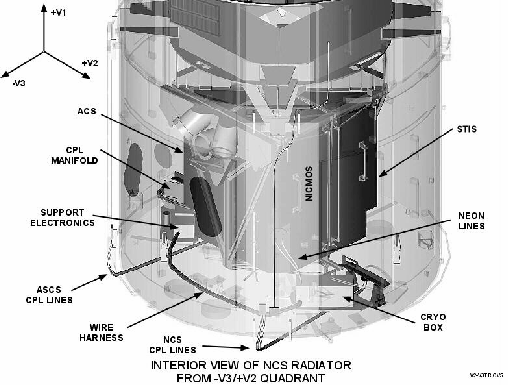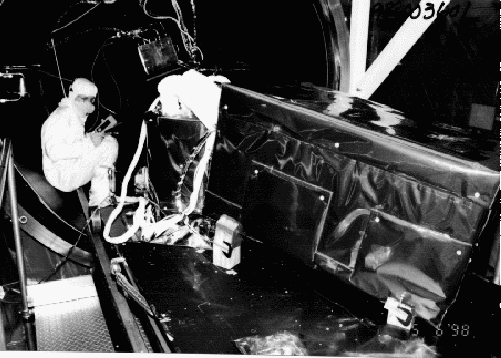 |
John W. MacKenty Space Telescope Science Institute, Baltimore MD 21210 USA, Email: mackenty@stsci.edu
Edward S. Cheng NASA Goddard Space Flight Center, Greenbelt MD 20771 USA, Email: ec@cobi.gsfc.nasa.gov
NASA is developing the NICMOS Cooling System (NCS) to provide operation of NICMOS beyond the exhaustion of its stored solid nitrogen cryogen. It is planned that the NCS will be installed into HST in early 2000 during the Third HST Servicing Mission (SM3). This development was motivated by the development of a thermal short within the NICMOS dewar which has reduced the cryogen lifetime from a planned 4.5+ years to slightly less than 2 years. While the acceleration of the the NICMOS observing program and the selection of a second round of General Observer proposals will permit NICMOS to obtain up to 70 percent of its originally anticipated observations, the extension of the NICMOS operational period will both enable additional science programs and provide HST with a near infrared capability potentially until the end of the HST mission.
The NCS combines an external radiator identical in design to the ACS/STIS Aft Shroud Cooling System (ASCS) planned for SM3, a Creare, Inc. reverse-Brayton cycle turbine cooler, and an EVA installed neon loop to the NICMOS dewar's cooling coil. This system has been assembled and is undergoing system level testing in May 1998. A validation flight on the HOST pallet onboard STS-95 in October 1998 is planned. We discuss the design of the NCS and the expected post-SM3 performance of NICMOS with the NCS.
NICMOS,cryocooler,HST,SM3,ASCS,spaceinfrared
The Near Infrared Camera and Multi-Object Spectrometer (NICMOS) was installed on board the Hubble Space Telescope (HST) by NASA during the Second HST Servicing Mission to provide a near infrared capability. Scientifically useful operation of NICMOS requires that its HgCdTe focal plane detector arrays (FPAs) be maintained at temperatures below approximately 80K. By design, the NICMOS FPAs are operated between 58 and 62 Kelvins with cooling provided by an expendable supply of solid nitrogen. The dewar containing the FPAs and solid nitrogen supply was designed for an on-orbit of lifetime of 4.5 to 5 years with the exhaustion of the nitrogen cryogen being the limiting factor. Unfortunately, internal stresses in the dewar caused physical motions shortly following the deployment of NICMOS into HST. These motions resulted in direct contact developing between baffles on the innermost cold solid nitrogen dewar and its surrounding cooled shell. The planned long lifetime of the nitrogen supply was to be achieved by a series of well isolated cold shells placed in hard vacuum around the inner nitrogen container. The innermost shell was cooled by the vented nitrogen gas and provided the cooling for the filters and spectral dispersing elements. This vapor cooled shell is known as the VCS. (The outer two shells are cooled using thermal electric coolers.)
The result of this physical contact between the inner dewar and the VCS was a thermal short which approximately doubles the heat flux into the solid nitrogen cryogen. The anticipated on-orbit lifetime of NICMOS was thereby reduced to approximately 22 months. Considering the initial commissioning period, this will reduce the period of NICMOS science observations to about one third of the original goal.
With the advice of outside committees, NASA and STScI have accomplished a partial recovery of the NICMOS science opportunity by accelerating the NICMOS observing program at the expense of observations with other science instruments on HST. By assigning NICMOS 40-50 percent of the total HST time available until mid-November 1998, STScI will be able to complete all GTO, and GO Cycle 7 and 7-NICMOS TAC approved programs. This, with the inclusion of the additional Cycle 7-NICMOS Call for Proposals, will result in the acquisition of 60-70 percent of originally anticipated NICMOS science return.
Beyond the recovery of the NICMOS capability, the addition of the NICMOS cooling system and its associated aft-shroud cooling system provides two other benefits.
First, the HST aft-shroud thermal situation will limit simultaneous Science Instrument operations starting in the 2001 timeframe. This is the result of increasing power demands of the new generations of instruments (e.g. STIS and ACS) and the normal aging of the outer surfaces of the spacecraft. A second radiator of the same design adopted for NICMOS and a shared control electronics subsystem provides a means of directly cooling ACS, STIS, and potentially COS together with the ASCS itself.
Second, the NCS permits a flight demonstration of long life cryocooler system which is desirable for future space missions. For example, the Creare cryocooler system within NCS is the leading technology candidate to provide the Next Generation Space Telescope (NGST) with sufficient cooling to support a mid-infrared (thermal) IR instrument.
In general, the NCS is expected to restore NICMOS approximately its condition prior to the exhaustion of the nitrogen cryogen. The temperature at the FPA detectors will be 72-75 Kelvins (compared to 61 Kelvins in June 1998). This will increase the dark current from 0.05 e-/s to 0.5 or 1.0 e-/s. Even for fairly long exposures, the readout noise of approximately 30 electrons will dominate the dark current. Only very long narrow band exposures at wavelengths shorter than 1.8 microns have a significant potential loss in performance. As a minor benefit, the quantum efficiency of the detectors at short wavelength will increase by perhaps one third. The filters, which are viewed by the entire wavelength response of the detectors, are expected to be cooled below 160 Kelvins (which is actually closer to their original design temperature than their present 100 Kelvins). Therefore, background from filters is expected to remain undetectable.
Image quality is expected to be equivalent to that obtained during late 1997 and 1998 (with Camera 3 remaining several mm out of focus). Although considerable uncertainties regarding the behavior and state of the dewar structure remain, it appears very unlikely that Camera 3 will be recovered into the internal focus adjustment range of the NICMOS pupil alignment mechanism (PAM). Therefore additional ``NIC3 campaigns'' in which the telescope focus is shifted may still be required to obtain the very best possible image quality in NICMOS Camera 3.
During NCS operation, the temperature stability of the detectors will be an important parameter. The goal is stability of 0.05K during one orbit and 0.2K long term. Temperature variations will create bias shifts (similar to the “pedestal effect”) and may require similar calibration efforts. Although the NCS requires consider power to operate (equivalent to approximately 1.5 science instruments), present indications are that full time operation will be possible until at least 2003 (at Servicing Mission 4) and potentially beyond although NICMOS+NCS campaigns may be required.
The NCS Requires 5 distinct elements: (1) a flexible neon loop connection between the NICMOS dewar cooling coil and the NCS heat exchanger, (2) the Creare Cryocooler, (3) the Power Conversion Electronics, (4) the Electronics Support Module, and (5) two externally mounted radiators. Figure 1 shows the main elements as they will be installed inside HST.
 |
The actual cooling of the interior of the NICMOS dewar is accomplished by circulating 65 to 70 Kelvins neon gas through the cooling coil at the aft end of the dewar. This coil was originally used to solidify the nitrogen cryogen within the dewar by passing cold Helium gas through it during ground assembly of NICMOS. This coil is accessible via two bayonet fittings on the side of NICMOS to which the ``flex Lines'' will be attached by an astronaut during SM3. The requirement on the cooling system is to provide 400 milliwatts of cooling power into the dewar.
The Creare, Inc. mechanical cryocooler system uses a reverse-Brayton cycle turbine design which provides several major advantages for this application. First, this closed loop system operates with extremely high speed -7 kHz- turbines so the potential for mechanical coupling to the HST is very small. Since HST has very demanding pointing requirements (7 milliarcseconds with actual performance frequently better than 3 milliarcseconds), avoiding disturbances is crucial. Second, this system can provide the degree of cooling required. Since the parasitic losses within the astronaut installed flex lines and the bayonet couplings are rather large, delivering 400 mW into the NICMOS dewar is expected to require 7 to 8 Watts from the cooler. Third, the Creare design is sufficiently compact in physical size to fit within presently unused space between the aft end of the NICMOS instrument's enclosure and the aft bulkhead of the HST.
The Creare cryocooler is connected to the flex lines cooling loop by means of a heat exchanger operating at 62 Kelvins. It is contained in the NICMOS CryoCooler (NCC) enclosure together with gas storage bottles to purge, pressurize, and -if necessary- re-pressurize the external neon loop. A cutaway view of the NCC is shown in Figure 2 and the assembled unit (minus its external thermal blankets is shown in Figure 3. Note the MLI blanket encased flex lines extending from the box on the left side.
The Power Conversion Electronics (PCE) is required to produce the AC power required by the Creare cryocooler and is located within the same enclosure as the Creare cooler (the NCC box). The cooler will require up to 400W during the initial cooldown phase.
The Electronics Support Module (ESM) contains a microprocessor to control both the NCS and the Aft-Shroud Cooling System (ASCS). This system is commanded via an HST remote interface unit (RIU), the same path used by each science instrument. Even in the absence of the NCS, the ESM would be required to control the ASCS cooling support for ACS and STIS.
The Aft-Shroud Cooling System (ASCS) consists of two externally mounted radiators as illustrated in Figure 4. One is dedicated to NICMOS+NCS while the other supports all other SIs and the ESM. Heat is transferred to these radiators by Capillary Pumped Loop (CPL) lines to be installed by the astronauts. Heat flow along CPL lines is regulated by the ESM by means of heaters attached to each end of a CPL line. The CPL lines are connected to the ACS and STIS instruments at interface plates. A view of the NICMOS radiator under construction is shown in Figure 5
The NCS poses several challenges for the HST Servicing process. First, the entire system is not available for testing since NICMOS is presently installed in HST. Second, the time available for the development of the NCS is very short (ar the start of the NCS development effort in mid-1997 SM3 was scheduled for November 1999 - it is now scheduled for May 2000 due to events external to the HST project). And third, the Creare cryocooler system has not yet been tested under zero gravity conditions.
To address these factors, the NCS development process includes plans to test the flight-NCS in space during STS-95 as part of the Hubble Orbital System Test (HOST) payload. This space shuttle flight is currently scheduled for October 1998. A thermal simulator of the NICMOS dewar with a high fidelity replica of the cooling coil and its interface plate has been constructed to support this testing both on the ground and during the HOST flight.
Previous testing of the Creare cryocooler has demonstrated operation for more than 1.5 years with the most critical turbine component having over 13 years of life testing. During the first half of 1998, the NCS flight components have been integrated and are presently undergoing testing in thermal vacuum chambers at Goddard Space Flight Center (Figure 6). The development of the NCS and the ongoing evaluation of the technical and scientific performance of NICMOS has been, and will continue to be, reviewed by an Independent Science Review board. The final decision to proceed with installation of the NCS into HST will depend upon the outcome of the ground and HOST mission testing and the findings of this review board.
 |